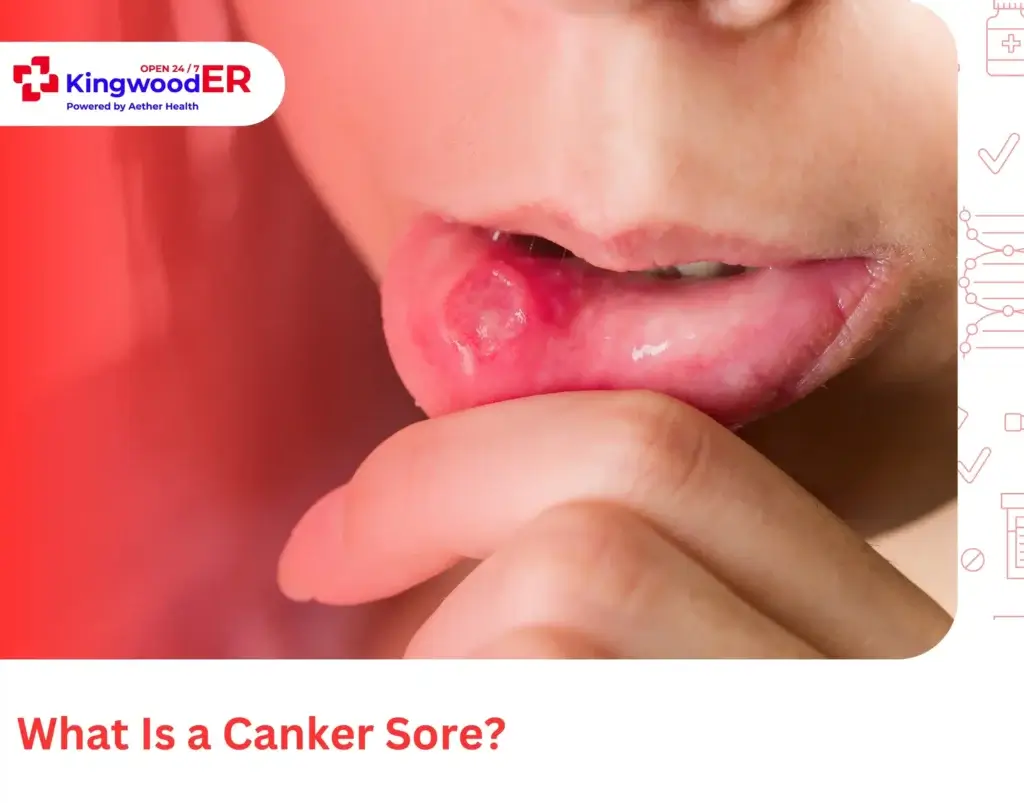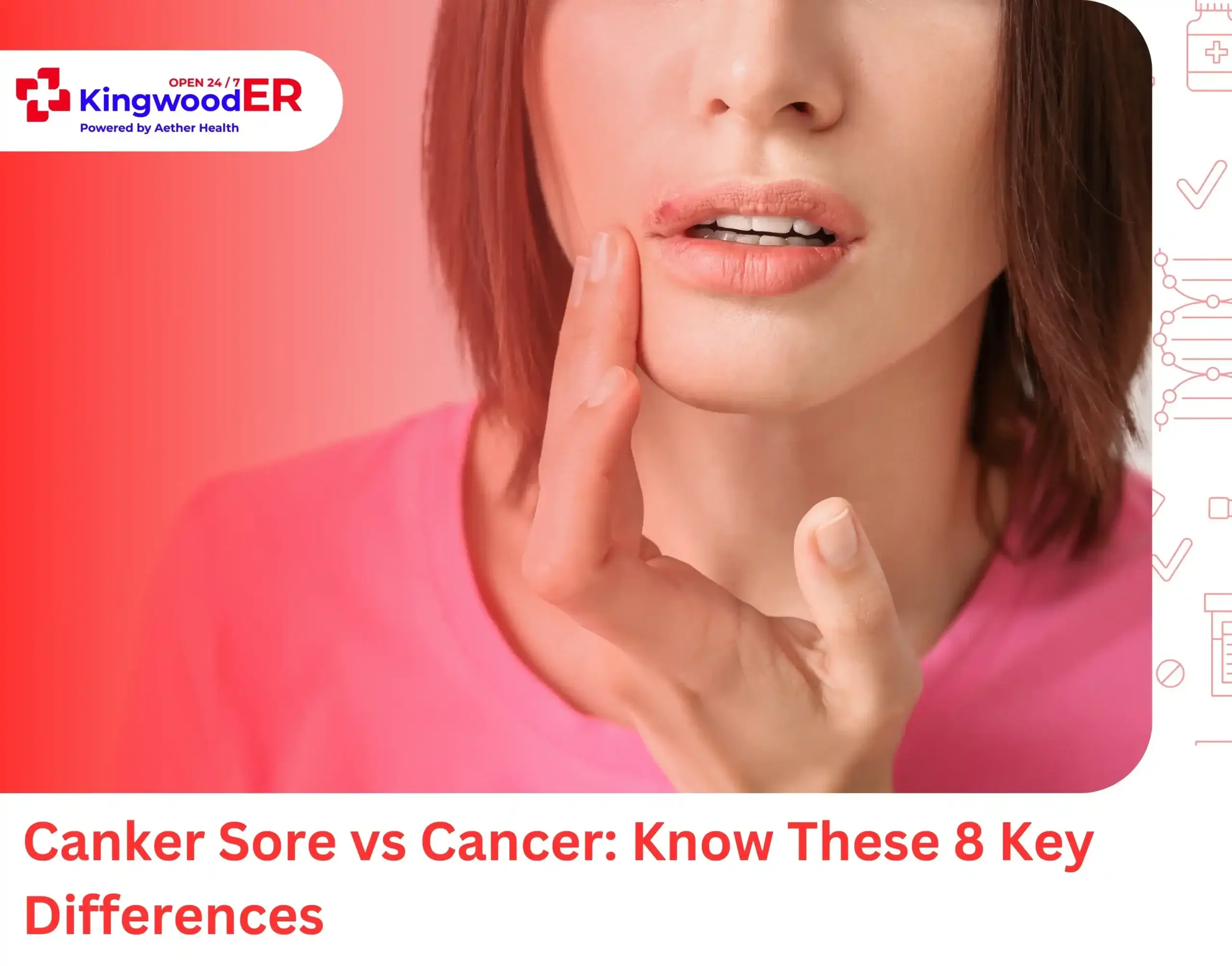A sore in our mouth, we often think it’s from biting our cheeks, eating something hard, or brushing too aggressively. If it heals and disappears on its own, it’s likely just a canker sore.
But what if it doesn’t heal after three weeks and starts to hurt more? That could be a sign of oral cancer, that requires immediate medical attention. The canker sore vs cancer distinction is crucial, because early detection of oral cancer carries a 90% survival rate. But if oral cancer is found in later stages III or IV, the survival rate drops to 5–20%.1
Learning the difference between the signs of a canker sore vs oral cancer could literally save your life.
What Is a Canker Sore?

Canker sores, or “aphthous ulcers,” are tiny wounds inside the mouth. They can appear on your tongue, cheeks, gums, or the soft part of the roof of your mouth. These sores are not fluid-filled or contagious like blisters.
If you notice a sore while brushing your teeth that is white or yellowish in the middle and has a red border around it, it’s a canker sore. Most canker sores heal on their own in about 7 to 10 days.
Causes of Canker Sore
These painful bumps are triggered by:
- Stress
- Minor mouth injuries (like biting your cheek)
- Certain foods (think citrus, spicy stuff, chocolate)
- Hormonal changes
- Vitamin deficiencies (like B12, iron, or folate)
- Even things like toothpaste containing sodium lauryl sulfate
What Is Mouth Cancer?
Oral or mouth cancer is when healthy cells in the mouth, like squamous cells, mutate and grow out of control. Over time, these cells pile up and form a tumor. Things like smoking, drinking a lot of alcohol, HPV infection, and too much sun on your lips can raise the risk of oral cancer.
Mouth cancer usually starts as a small sore, or patch that doesn’t typically hurt at first. But if not caught early, it can spread to other parts of your body and get serious. Common signs of mouth cancer include:
- A sore that doesn’t heal (lasting longer than 2-3 weeks)
- A lump or thick spot on the cheek
- A persistent red or white patch
- Pain or numbness in the mouth
- Trouble chewing, swallowing, or even speaking clearly
Causes of Mouth Cancer
Common risk factors include:
- Tobacco use (smoking or chewing)
- Heavy alcohol consumption
- Human papillomavirus (HPV) infection
- Excessive sun exposure to lips
- Weakened immune system
- Previous cancer history
- Genetic predisposition
8 Critical Differences Between Canker Sore vs Cancer

Understand the differences between canker sores and oral cancer for timely diagnosis and treatment. Below are key distinguishing features:
1. Pain
Canker Sore: Typically causes sharp or burning pain, especially when eating, drinking, or speaking. Sometimes, the pain shows up before you notice any sore or lump in your mouth. The pain usually fades away as the sore heals, but still painful during the healing process.
Oral Cancer: Unlike canker sores, oral cancer often starts as a painless small lesion. But as the cancer develops, you’ll start feeling a constant sharp pain that makes eating, talking, or swallowing difficult.
2. Appearance
Canker Sore: Small (usually less than 1 cm), round or oval ulcers with a white or yellowish center and a red border. They are flat or slightly sunken and feel tender to the touch.
Oral Cancer: They are white, red, or mixed red and white patches. They may look like a regular sore, but stay around longer. Also, they may bleed or have a crusty appearance.
3. Healing Time
Canker Sore: Heals completely on its own within 7 to 14 days without leaving any scarring.
Oral Cancer: Cancerous lesions persist beyond two weeks and typically worsen rather than improve over time.
4. Location
Canker Sore: Occurs on mucosal surfaces, such as the inside of lips, tongue, or soft palate. They do not appear on the outer lips or skin.
Oral Cancer: Can develop on any part of the mouth, including the tongue, lips, gums, inner cheeks, floor or roof of the mouth, and throat.
5. Prevalence
Canker Sore: Around 20% of people will get a canker sore at some point in their lives.2 They’re more common in women, not entirely clear why, but hormonal factors (like changes during menstruation or pregnancy) may play a role.
Oral Cancer: The lifetime risk of developing an oral cancer is about 1 in 59 for men and 1 in 139 for women in the US.3 Men are about twice as likely to develop these cancers, possibly due to higher rates of risk factors like smoking and heavy drinking. Though this gap is narrowing as lifestyle factors change.
6. Other Symptoms
Canker Sore: Generally limited to localized pain without systemic symptoms. No associated numbness, bleeding, or significant swelling.
Oral Cancer: May present with additional symptoms such as unexplained bleeding, numbness, difficulty swallowing, sore throat, hoarseness, loose teeth, or a lump in the neck.
7. Risk Factors
Canker Sore: Often triggered by stress, minor mouth injuries, acidic or spicy foods, vitamin deficiencies, hormonal changes, or certain toothpaste ingredients.
Oral Cancer: Strongly linked to tobacco use, excessive alcohol consumption, human papillomavirus (HPV) infection, prolonged sun exposure to the lips, and a family history of cancer.
8. Treatment
Canker Sore: Typically resolves without medical intervention within a week. Over-the-counter treatments can alleviate the temporary discomfort.
Oral Cancer: Requires prompt medical evaluation and treatment, which may include surgery, radiation therapy, or chemotherapy, depending on the stage and location of the cancer.
| Feature | Canker Sore | Mouth Cancer |
| Pain | Sharp pain from start | Often painless at first, then persistent |
| Appearance | Small with white/yellow center and red border | White/red patches that may bleed |
| Healing | 7-14 days | Persists beyond 2 weeks |
| Location | Only on soft tissues inside mouth | Can appear anywhere in mouth |
| Prevalence | 20% of population, more in women | 1 in 59 men, 1 in 139 women |
| Other Symptoms | Localized pain only | May include bleeding, numbness, swallowing issues |
| Risk Factors | Stress, minor injuries, diet | Tobacco, alcohol, HPV, sun exposure |
| Treatment | Self-resolving, OTC remedies help | Requires medical intervention |
This canker sore vs mouth cancer comparison highlights why it’s crucial to monitor any mouth sore that doesn’t heal within two weeks. When in doubt, professional evaluation is your safest option.
When Should You See a Doctor?

Distinguishing between canker sore vs cancer requires professional assessment in certain cases. Don’t delay seeking medical attention if you experience:
- Mouth sore that lasts longer than two weeks
- A painless growth or lesion that continues to enlarge
- Numbness in any part of your mouth or face
- A white or red patch that doesn’t go away
- New lumps or thick areas inside your mouth or on your lips
- Difficulty swallowing, chewing, or moving your tongue or jaw
- Unexplained weight loss or ear pain accompanying a mouth sore
- Swollen lymph nodes in your neck
If you’re unsure about any persistent mouth sore, consult a healthcare professional immediately. Remember that most mouth sores are benign, but proper evaluation provides peace of mind and ensures timely treatment if necessary.
How ER Kingwood Treats Canker Sore vs. Cancer
When you visit ER Kingwood with concerns about a mouth sore, here’s what you can expect:
Initial Evaluation
Our emergency physicians will listen to your concerns and ask about your symptoms, such as:
- How long the sore has been present
- Any pain or discomfort you’re experiencing
- Whether the sore has changed in appearance
- Any recent injuries, changes in diet, or stress factors
- Exploring risk factors like smoking, alcohol use, or family history
Physical Examination
Next, the team will perform a thorough examination of your mouth, tongue, gums, and throat. We need to assess if it is a typical canker sore or if there are any signs of oral cancer. Key indicators we’ll look for include:
- Size, shape, and appearance of the sore
- Any lumps or bumps in the mouth
- Bleeding, white patches, or thickened areas
- Any difficulty or pain when chewing, swallowing, or talking
Diagnostic Tests
Based on the physical examination and your reported symptoms, we’ll make an initial diagnosis:
- Canker Sore: If the sore is typical of a canker sore (small, shallow, round, or oval, with a white or yellow center and a red border), over-the-counter medications for pain relief. Most canker sores resolve in 1–2 weeks with proper care. We may prescribe mouthwashes to promote healing and reduce irritation. We also give recommendations on dietary changes to prevent further irritation.
- Oral cancer: We may perform imaging tests (like X-rays or CT scans), lab tests to check for infections or other conditions, and blood work to evaluate your overall health status.
Kingwood ER is equipped with advanced diagnostic equipment including digital X-rays and comprehensive laboratory testing services, allowing for prompt evaluation right at our location.
Immediate Treatment
Once a diagnosis is made, our team will discuss your treatment options.
For canker sores, we provide:
- Pain management recommendations
- Medicated rinses to promote healing
- Guidance on home care and dietary adjustments
For suspected oral cancer, we:
- Stabilize any immediate symptoms
- Provide preliminary treatment
- Coordinate appropriate follow-up care with specialists
Referral and Follow-up
If you’re diagnosed with a canker sore, we may ask you to come back if symptoms don’t improve or worsen. For conditions requiring specialized care, we coordinate referrals to appropriate specialists like oral surgeons or oncologists. Our team ensures that you leave with clear instructions for follow-up care.
Final Thoughts on Canker Sore vs Cancer
Don’t forget this rule of thumb: If canker sore lasts longer than 2 weeks, get it checked out. Catching something early, even if it doesn’t feel serious, helps keep you healthy by giving you peace of mind.
So, if something’s bothering you in your mouth, don’t wait for a conventional appointment. At ER Kingwood, we’re committed to giving you peace of mind without the long waits you’d find in a traditional setting.
Don’t leave your health to chance. We’re here to help you feel better.
FAQs
1. Can oral cancer resemble a canker sore at first?
Yes. Oral cancer and canker sores can have some overlapping symptoms. Both can cause sores or patches in the mouth, but canker sores typically heal within a couple of weeks, while oral cancer doesn’t heal.
2. Can a canker sore become cancerous?
No, a canker sore does not become cancerous. Unlike oral cancer, canker sores are benign ulcers that are usually harmless and heal within a week or two.
3. What Are Quick Tips to Soothe a Canker Sore?
To ease a canker sore, try rinsing with saltwater (1 teaspoon of salt in warm water). Avoid spicy or acidic foods like oranges and hot sauce.. Stay hydrated, brush gently with a soft toothbrush, and skip alcohol-based mouthwashes.



